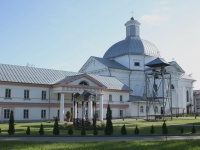- Home
- →
- Attractions
- →
- Piarskii collegium in Schuchin
Piarskii collegium in Schuchin
The Piarist Collegium of Shchuchyn is an outstanding monument of religious and educational architecture of the 18th century, located in the town of Shchuchyn, Grodno Region. The complex is associated with the activities of the Piarist Order — a Catholic monastic order that for many years developed educational and enlightenment work in the region. The collegium became one of the leading centers of education in the Grand Duchy of Lithuania and later in the Russian Empire.
Today, this historical site is partially preserved, and its architecture, despite some losses, still allows us to imagine the scale and importance of the institution. The building is included in popular tours across Belarus, and during a guided tour it is possible to learn how education was organized, who taught there, and what the mission of the Piarist Order was. For those who want to learn more about the history of education in Belarus, it is highly recommended to book a tour to Shchuchyn.
History of the Collegium
The history of the collegium began in 1718, when the then-owner of Shchuchyn, Jerzy Glembicki, invited monks of the Piarist Order to the town. They settled near the local church and opened a school, which became the first step toward forming a full-fledged educational institution. In 1726, the Sejm officially confirmed the establishment of the Piarist Collegium in Shchuchyn.
The educational system included a paid three-class primary parish school, which was not accessible to peasant children. Only after completing this school could a student enroll in the collegium, where education was free. The collegium was designed for 140 students. The institution owned two farmsteads, a garden, and a vegetable plot, which ensured its autonomy.
By 1735, 170 students had already completed philosophical preparation. Despite its official status as a secondary school, the collegium was comparable to a university in terms of its academic level, teaching staff, and library collection. The active participation of students and alumni in the 1830–1831 uprising led to the closure of the collegium by the tsarist authorities. It was reopened only in 1927. After the Soviet government came to power in 1939, the Piarist Order and the church were abolished, and the collegium ceased to function — but the memory of it remained, and today it is considered an important part of the region’s cultural and historical heritage.
Architecture of the Collegium
The Piarist Collegium of Shchuchyn was built according to a typical design for its time: it was an architectural ensemble combining educational and residential premises with a religious center. The buildings were constructed in the late Baroque style with elements of Classicism, characteristic of 18th-century Catholic monasteries.
The main building had two floors, a symmetrical layout, massive vaults, and spacious classrooms. Special attention was paid to the library, which housed valuable handwritten and printed books, including works by foreign authors. On the territory of the collegium were the monks’ living quarters, student rooms, and utility buildings that supported the functioning of the school.
Today, the building is partially preserved and attracts the interest of both tourists and architectural historians.
Tours with a Visit to the Collegium
Shchuchyn is included in the routes of many tours across Belarus, including tours from Minsk, thanks to its rich historical heritage. Visiting the former Piarist Collegium allows you to immerse yourself in the atmosphere of the Enlightenment movement of the 18th century, learn more about the mission of the Piarist Order and the lives of its students.
During a guided tour of the collegium, you will find out how the Piarists taught, how the library was formed, what student life was like, and why the collegium was considered an elite educational institution. A guide will explain the collegium’s importance to the development of education in the region, its role in historical events, and how the fate of the building evolved in the 20th century.
To learn more, you can book a tour on the Ekskursii.by website — the largest platform for booking tours across Belarus. It’s a great opportunity to explore lesser-known but significant chapters of Belarusian history.

